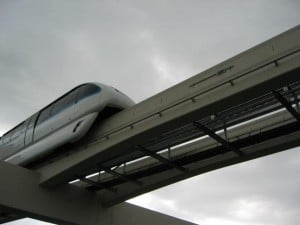A colleague and I go around and around over what type of transportation system is better at reducing emissions. In the automotive realm, indeed significant strides have been made. There are battery powered cars and hybrids already sharing space with other less-environmentally friendly types on the road. In the grand scheme of things, however, if there is indeed strength in numbers, in this regard there is still a ways to go.
Then there’s transit.

“In 1962, President Kennedy began a move towards achieving ‘good urban transportation, with properly balanced use of private vehicles and modern mass transport to help shape as well as serve urban growth.’ This led to the Urban Mass Transportation Act of 1964, amended in 1966 to mandate ‘a program of research, development and demonstration of new systems of urban transportation that will carry people and goods within metropolitan areas speedily, safely, without polluting the air, and in a manner that will contribute to sound city planning.”
Work in the “new urban transit systems” area has been ongoing and there has been success to an extent. Principally, what we’re talking about here are alternative modes, meaning the more unconventional, non-traditional transportation selections such as the broadly categorized personal rapid transit and group rapid transit-type systems or, in other words, personal or group transport systems.
And there are loads of them. Everything from the Las Colinas (Irving, Texas) Area Personal Transit (APT) offering (in operation since June 1989), the Morgantown, West Virginia Group Rapid Transit (GRT) line (a circulator in service since 1975) and Las Vegas, Nevada monorail systems to the ultra-modern if not more revolutionary designs and approaches like CyberTran, skyTranTM, VECTORRTM, and Tubular Rail, to name just four.
These systems and others like them could be the wave of the future. But, of course, this hinges on a multitude of factors, namely, the current and future price and availability of gasoline, for instance.
On the other hand, conventional rail and bus mass transportation systems are quite effective in terms of emissions reductions, the electrified systems in particular, that is, provided there is a sufficient ridership base to justify their existences.
So, until the aforesaid ultra-modern-type systems and/or others are able to carve out a definitive niche and become a competitive force to be reckoned with, meaning they become publically accessible for viewing and riding and experiencing first hand, my suspicion is the conventional or traditional modes – or what my colleague in the past has referred to as “the incumbents” – will continue to dominate the public transit arena.
With that said, transit might just be the best thing going when it comes to mitigating negative environmental impact.
– Alan Kandel